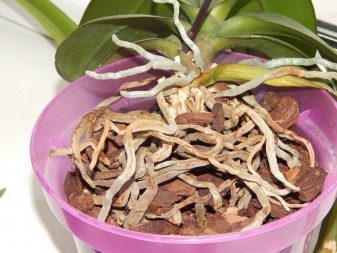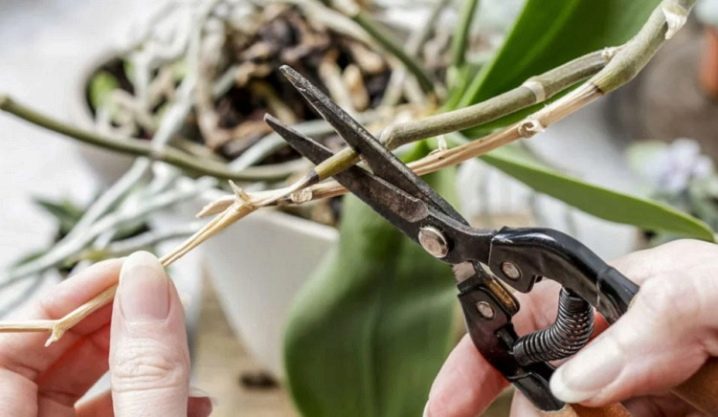All about orchid aerial roots

One of the main problems of a modern city is the presence of a large number of concrete structures and the lack of a sufficient number of green areas. When decorating apartments, houseplants are often used, which not only decorate the living space, but also purify the air and improve the overall atmosphere in the room. Houseplants can be purchased at specialized flower shops. For many years, one of the most popular indoor flowers is the orchid.

Reasons for the appearance
Orchid is a striking representative of tropical plants that has an unusual root system. It belongs to the family of epiphytic plants and has not only ordinary roots, but also aerial ones. This plant was brought to European countries from regions with a tropical climate. Initially, aerial roots helped the plant to attach to tree trunks, rocks and huge stones, and also made it possible to receive water and all nutrients from humid air. The main feature of the orchid is the use of large plants only as a support for growth, and not as a source of nutrients.
Unique structure of thick and cylindrical aerial roots, the surface of which has a porous and spongy structure, enables the flower to accumulate moisture and minerals and, if necessary, use it for growth and development. To reduce the level of mechanical damage, the plant has a special protective brown layer - velamenu. In the dry climate of an ordinary apartment, the plant produces a lot of aerial roots, which appear during the entire period of life and provide additional moisture supply. Potted plants put aerial roots into the soil.

How are they different from ordinary ones?
Orchid is a unique plant that does not grow in soil under natural conditions. Aerial shoots do not have a central root system and grow along the main stem, sometimes above the lower leaves. The root system of a plant grown under artificial conditions, part of the aerial roots of which is placed in the ground, has thicker and more powerful aboveground processes than underground ones. A more pressing issue for novice gardeners is finding the differences between peduncles and aerial roots due to the formation of the same gap at the base of the leaf when it appears.
The air root has the following distinctive features:
- location between leaves on the root collar;
- downward direction of escape;
- the shape of the smooth root primordium is obtuse, rounded.


Their main functions
The main function of aerial roots is to provide the plant with the necessary nutrients. The aerial root system of the orchid is of great functional importance in its growth and full development, and also contributes to the formation of new shoots. In natural conditions, the plant is forced to adapt to life on the branches of large trees and rocks, on which these shoots help to gain a foothold. Due to the impossibility of obtaining moisture and nutrients from the soil, the orchid is forced to use air vents, which absorb, accumulate moisture particles from the air and are adapted to absorb sunlight.Aerial shoots serve as an indicator of plant health and age.
To determine the age of orchids, you need to pay attention to the color scheme of its roots:
- young plant - bright green palette;
- old flower - pale and muted shade.


Important! The absence of the formation of young roots over a long period of time is a sign of improper care, a decrease in immunity and the possible development of various diseases.
What to do with them when transplanting?
Like any other plant that is at home, the orchid needs timely care and transplantation. When changing the nutrient soil and pot, experienced gardeners do not recommend covering the roots with earth and burying them in a flower container. Aerial shoots should be left completely open on the soil surface or covered with a small amount of mosswhich will enable them to retain moisture for a long period of time. If it is necessary to obtain a new plant, experts recommend reproducing it simultaneously with the transplant. For planting, you need to choose healthy roots that have several pseudobulbs.

The cutting off of the planting material is carried out with a sharp knife, and the place of the cut is sprinkled with activated carbon powder.
Do I need to trim them?
The orchid is an unusual plant that has a non-standard root system. Many novice gardeners, trying to give the flower a classic appearance, cut aerial shoots. This manipulation is not only impractical, but can also damage a healthy flower. Experienced gardeners recommend removing roots only in exceptional cases for obvious reasons.
The following reasons for trimming the air outlets are possible:
- decay;
- drying out;
- withering away.

It is worth paying attention to the following signs of roots that need to be removed:
- discoloration of shoots that turn brown, yellow, or black;
- the presence of an oily surface;
- the appearance of cracks;
- a significant decrease in their volume;
- the appearance of wrinkles.
Healthy roots, which are strictly forbidden to be removed, have the following features:
- dense and fleshy structure;
- smooth and even surface;
- bright colors;
- lack of mechanical damage and signs of fungal diseases.

Important! In the presence of a powerful, long and healthy root system of a pale green color with a silvery sheen, it is strictly forbidden to remove and injure it.
Subtleties of care
To obtain a healthy plant with a moderate number of aerial shoots, you must carefully study all the intricacies of caring for it. The following rules for caring for an orchid should be adhered to:
- placing the plant on a vertical support without a container with soil;
- transplanting a plant into a transparent pot in the absence of the possibility of hanging growing;
- the use of additional lighting devices;
- protection from direct sunlight;
- creating a comfortable temperature regime, which is in the range from +16 to +30 degrees;
- implementation of daily watering in summer and 3 times a week in winter;
- regular application of organic and mineral fertilizers;
- carrying out a spring plant transplant.

Plant transplantation must be carried out according to the following recommendations:
- removing a flower from an old pot;
- removal of old soil from the surface of the root system under a stream of running water at room temperature;
- removal of damaged and dry parts of the plant;
- disinfection of cutting sites;
- laying drainage materials at the bottom of a new flower container;
- placing the plant in a pot and carefully filling the container with nutrient soil without compaction.

When a large number of aerial shoots are formed, botanists distinguish the following types of reasons:
- high level of temperature conditions in the room;
- low percentage of air humidity;
- excessive soil moisture;
- poor lighting of the room;
- increased soil density.

In the absence of an underground root system, experienced gardeners recommend increasing it. To carry out this procedure, you need to place the flower in a container with water, in which an accelerator of root formation, phytosporin, a little honey and sugar, as well as a complex of vitamins of group B are added. A prerequisite before growing roots is to remove damaged areas of the plant and disinfect the cut sites. The optimum air temperature in the room is +28 degrees. To fill the cells on the surface of the leaves with water, you need to regularly wipe them with an aqueous solution of succinic acid, because it is an indispensable assistant in strengthening the immune system and in the formation of a strong root system.
Watering a tropical plant can be done in such ways as:
- shower - washing the entire plant with room water using a shower; after the procedure, the aerial roots should have a rich green color;
- immersion - completely lowering the pot into a container of water for a short period of time;
- regular watering - moistening the soil by watering it with a special garden watering can;
- spraying is the best way to moisturize the plant.

Experienced gardeners do not recommend watering in the evening and at night. For irrigation, use built-up water with a minimum concentration of mineral salts. To determine the level of water hardness in specialized departments of pet products, special tests must be purchased. It is forbidden to apply fertilizers to dry and unmoistened soil. In the case of overdrying the flower, it is forbidden to carry out frequent and abundant watering, which will stress the plant and provoke the development of putrefactive processes.
The most correct action is to carry out regular spraying.

Possible problems
Many orchid owners may experience dry and lifeless roots that dry out, die and break. When this problem occurs, experts recommend finding the reasons for their occurrence. Only a competent and comprehensive approach to solving this problem will help save your favorite plant. This plant can have several of the most common problems.

Drying of aerial shoots
This is the appearance of dry shoots. The reasons include the following factors:
- lack of moisture - low air humidity and abundant moisture in the nutrient soil;
- mechanical damage - injuries that the plant can receive during transportation or transplantation, especially the delicate buds of the plant;
- burn - damage to the root system caused by improper use of chemical fertilizers or watering with high chlorine content.

Fungal diseases
At the first signs of the appearance of dry processes, it is imperative to remove them and treat the cut sites with antiseptic drugs.

Putrefaction
Rotting is the appearance of dark processes that have a loose and moist structure. The causes of the disease include the following:
- high level of soil density;
- the presence of dangerous pests;
- abundant watering;
- applying a large amount of concentrated fertilizers;
- mechanical damage;
- late blight;
- brown rot.

To preserve the plant, it is necessary to transplant it into a new soil with the preliminary removal of rotten shoots and treatment of the roots with antiseptic agents.
Drying of underground roots
The causes of this disease can be the following:
- the effect of low temperatures;
- lack of watering;
- overheating of the plant;
- salting the soil and the occurrence of burns;
- fungal infection;
- the presence of dry rot.

Mold plaque
This disease can manifest itself for the following reasons:
- abundant watering;
- low ambient temperature;
- low light level.
Indoor plants are not only part of the overall interior of the room, but also helpers that improve the mood and atmosphere in the family, purify the air.
To create favorable conditions for the growth and development of plants, it is necessary to carefully study their features, as well as know the rules for caring for them.

For information on what to do with the aerial roots of an orchid, cut or bury it, see the video below.































The comment was sent successfully.